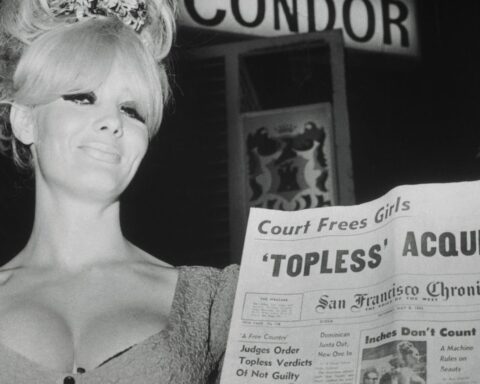The Disappearance of Shere Hite
(USA, 118 min.)
Dir. Nicole Newnham
Programme: U.S. Documentary Competition (World Premiere)
“I don’t think equality is dangerous,” replies Shere Hite. The late writer, researcher, and sexologist makes the pointed reply early in Nicole Newnham’s documentary The Disappearance of Shere Hite. It’s not the first time that Hite’s on the defensive in the film. Nor, by any means, is it the last.
The Disappearance of Shere Hite is easily a standout among the field of biographical documentaries at Sundance this year. Newnham (Crip Camp) captures Hite’s groundbreaking and controversial research with renewed insight. Moreover, as interviewees share a collective dismay that Hite’s name is likely unfamiliar to young generations, the film makes a strong case that many of the sexist double standards that forced Hite to disappear continue today. This smart and balanced portrait lets past and present collide to renew Hite’s plea for gender equality.
Dakota Johnson narrates the documentary from Hite’s first-person account. Her breathy and confident voiceover matches the composure that appears in the archival clips of Hite. The film situates Hite as a working woman in the late 1960s and early ’70s who struggled to find her place. Hite’s peers reflect how they and Hite were odd-ones-out in college because they wanted to explore issues of sexuality. Rinse-and-repeat dissertations on Shakespeare were fine, they recall, but new studies on women’s bodies were taboo. Newnham’s film shares how Hite studied history simply because there was no other field for her work. Male professors suggested “women’s studies,” as an alternate. It wasn’t a thing then, but rather low-blow sexism that would follow Hite throughout her career.
Methods and Misogyny
The Disappearance of Shere Hite marks its subject as a sharp thinker and innovator as she emerges from college. Newnham unpacks Hite’s criticisms of Masters and Johnson’s sex research, namely that it was still phallocentric with its findings on penetrative vaginal sex and women’s orgasms. Moreover, the film situates Hite’s own sexuality—her comfort with it, her unease exploiting it for misogynistic modelling campaigns, etc.—to root her methodology within subjective, personal experience. This facet proves important, both for her work’s significance and for its controversy.
Newnham devotes fair screentime to Hite’s methodology that led to the 1976 publication of her hot-button book The Hite Report on Female Sexuality. Hite explains her practice in various archival clips, which illustrate both the interest in her findings and efforts to dismantle them. Hite tells how she distributed surveys that invited women to answer anonymously over 150 long-form questions. The anonymity, Hit insists, is key to ensure accuracy. Women, the film notes, wouldn’t respond truthfully about sex, masturbation, orgasms, and adultery if they could be identified. The same arguably remains true today despite the relative advances in sexual freedom.
Interviewees unpack the rigorous methods that were then used to consider the data. Hite’s team, bankrolled by funds cobbled together from anyone from whom she could squeeze a few bucks, translated the answers from some 3000 responses into quantitative data. When The Hite Report was finally published, it hit like a bomb. Simply from the tone of voices in the archives, one sees the unease with which much of mainstream culture received the news that many women achieved orgasm through clitoral stimulation, rather than penetrative vaginal sex. Many male anchors couldn’t and would say the anatomical terms of Hite’s report.
Then Came the Backlash
While Newnham’s film valuably revisits Hite’s research to connect her name to new generations, what she finds in the archives makes Hite’s story doubly urgent. The publicity campaign for The Hite Report offers a case study in sexism. Clip upon clip shows Hite defending her work in interview after interview. A popular response to her book, mostly posed by male journalists but also female ones, is that it makes men irrelevant. Its publication evokes a collective emasculation from men worried about their virility. There’s mansplaining galore to be found as men roll their eyes about the women’s take on sex. Moreover, Hite becomes targeted as unreliable due to her own sexuality. With a shock of red hair, terrific fashion sense, and great screen presence, men don’t know what to do with her. The beautiful woman they’ve objectified in advertising now talks back.
The campaign worsens upon the publication of 1981’s The Hite Report on Men and Male Sexuality. Together, these books tell men things they don’t want to hear. Her book, for example, reveals overwhelming infidelity by men to their wives after two years of marriage. When news outlets try to debunk her work with their own research, America learns that women, too, are having extramarital sex. Hite pointedly asks her challenger: “With whom did everyone think these men were having sex?”
One particularly volatile clip sees Hite sitting opposite a panel of men. They haven’t read her books, but they have strong opinions about them. The same collective chauvinism greets Hite when Oprah Winfrey invites her to sit opposite an all-male audience. Hite fiercely defends the necessity of her work in the face of the men’s criticism. Namely: their words and actions directly reflect the responses of women and men who feel gender roles need revision.
The Cost of Speaking Up
The film observes the construction of the “man-hating feminist” and the backlash against the women’s movement. Newnham positions Hite as one woman among many who’ve faced reprisals for speaking up. Clips of Anita Hill’s testimony against Clarence Thomas, for example, show the patriarchy rearing its head. Trump, Kavanagh, and the #MeToo movement aren’t seen, but they haunt the film. Newnham doesn’t connect Hite with every parallel and she doesn’t have to. In the nearly 50 years since the publication of Hite’s work, many of the same problems persist alongside the strides made for equality.
The Disappearance of Shere Hite doesn’t suggest that Hite’s work, nor her persona, were perfect. In fact, Newnham shows that Hite could be overly defensive and occasionally combative. However, the portrait of her defensiveness, too, adds to the film’s power. Embedded within her work, flaws and all, is a rallying cry to move beyond rigid and established systems. This film speaks with a fiery spark that should empower generations of viewers who share Hite’s hunger for change. And if it irks another generation of men unwilling to accept progress, then so much the better.













